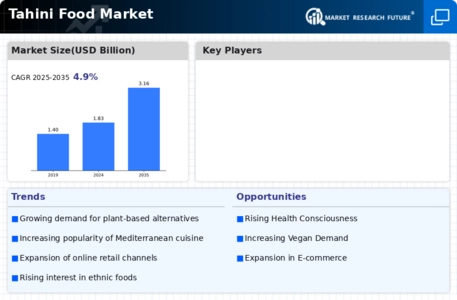Market Growth Projections
The Global Tahini Food Market Industry is poised for substantial growth, with projections indicating a market value of 1.83 USD Billion in 2024 and an anticipated increase to 3.16 USD Billion by 2035. This growth trajectory suggests a compound annual growth rate (CAGR) of 5.08% from 2025 to 2035. Such figures highlight the increasing consumer interest in tahini, driven by health trends, culinary versatility, and cultural influences. The market's expansion reflects a broader shift towards healthier eating habits and the incorporation of diverse ingredients in global cuisines. This growth presents opportunities for producers and retailers to capitalize on the rising demand for tahini.
Growing Health Consciousness
The Global Tahini Food Market Industry experiences a surge in demand as consumers increasingly prioritize health and wellness. Tahini, rich in nutrients such as protein, healthy fats, and vitamins, aligns well with the growing trend towards plant-based diets. This shift is evident in the rising popularity of Mediterranean cuisine, where tahini is a staple ingredient. As individuals seek healthier alternatives to traditional spreads and sauces, tahini's appeal broadens. The market is projected to reach 1.83 USD Billion in 2024, reflecting a growing consumer base that values nutritious food options. This trend indicates a promising future for the Global Tahini Food Market Industry.
Diverse Culinary Applications
The versatility of tahini contributes significantly to the expansion of the Global Tahini Food Market Industry. It is not only a key ingredient in traditional dishes like hummus and baba ghanoush but also finds its way into dressings, dips, and desserts. This adaptability allows tahini to cater to various culinary preferences and dietary restrictions, including vegan and gluten-free diets. As chefs and home cooks alike experiment with tahini in innovative recipes, its usage continues to diversify. This trend is likely to enhance market growth, as consumers increasingly seek out products that offer both flavor and functionality in their meals.
Expansion of Distribution Channels
The Global Tahini Food Market Industry is witnessing an expansion in distribution channels, which plays a crucial role in increasing product accessibility. Retailers are increasingly stocking tahini in mainstream grocery stores, health food shops, and online platforms. This trend facilitates consumer access to tahini, allowing it to reach a broader audience. The rise of e-commerce has particularly transformed the way consumers purchase food products, with online sales of tahini growing significantly. As distribution networks continue to evolve, the market is poised for further growth, ensuring that tahini remains a readily available option for health-conscious consumers.
Cultural Influence and Globalization
The Global Tahini Food Market Industry is influenced by cultural exchanges and globalization, which have introduced tahini to diverse culinary landscapes. As international cuisines gain popularity, tahini is increasingly featured in various dishes beyond its traditional Middle Eastern roots. This cultural integration is evident in the growing number of restaurants and food products that incorporate tahini into their offerings. The market is projected to reach 3.16 USD Billion by 2035, reflecting the expanding global appreciation for tahini. This trend underscores the potential for tahini to become a staple ingredient in kitchens worldwide, driven by its unique flavor and nutritional benefits.
Rising Demand for Plant-Based Products
The Global Tahini Food Market Industry benefits from the increasing demand for plant-based products, driven by a shift in consumer preferences towards sustainable and ethical eating. As more individuals adopt vegetarian and vegan lifestyles, tahini serves as an excellent source of plant-based protein and healthy fats. This trend is supported by a growing awareness of the environmental impact of animal agriculture. The market is expected to grow at a CAGR of 5.08% from 2025 to 2035, indicating a robust future for tahini as a staple in plant-based diets. This shift not only enhances tahini's market presence but also aligns with broader sustainability goals.











